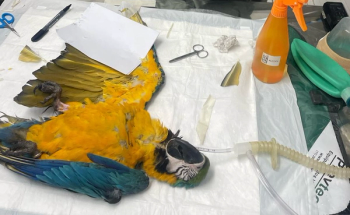
West Nile Virus remains top vector-borne threat this year
Experts predict the severity of vector-borne diseases, fleas and ticks will be a mixed bag in 2002 with the continuing spread of West Nile Virus still the biggest threat.
Experts predict the severity of vector-borne diseases, fleas and ticks will be a mixed bag in 2002 with the continuing spread of West Nile Virus still the biggest threat.
Entomologists and veterinarians agree dry weather does the most to break the cycle of some egg-laying pests in areas such as Florida, but up North, weather, cold or moderate, doesn't affect a lot of predators.
Mare reproductive loss syndrome (MRLS), which decimated foals in Kentucky last year, may only have a 1 in 20 chance of returning to Kentucky, and the tent caterpillar may not be to blame.
Lyme disease, while still a threat, is at least under control.
How's the weather?
Dr. James Becnel, research entomologist, Mosquito and Fly Research Unit, USDA-ARS, Gainesville, Fla., says populations of pests have been pretty low because of the extreme drought of many parts of the state.
Dr. Charles Stoltenow
Whether populations will remain low depends on how wet the rest of the season is, Becnel says. Predictions are in for a dry season until summertime.
On the flip side, the strength of the winter doesn't matter too much to our parasites in the North, because they're pretty good at surviving winter and the cold, says Dr. Charlie Stoltenow, extension veterinarian, North Dakota State University.
"The drier weather is what really helps to break the cycle, because it dries out the eggs," he says.
Adds Rhonda Pinckney, DVM, Ph.D., assistant professor, University of Wisconsin-Madison, Department of Pathobiological Sciences, although it's not "realistic" to predict a pest outbreak based on the weather, the areas of the country most at risk are those areas that stay relatively warm most of the year.
"There usually is not a killing frost and many of the parasite stages can live year round."
Experts predict that of the vector-borne diseases, the mosquito-transmitted West Nile Virus will likely have the most dramatic impact on animals.
As for individual pest threats, expect many to continue to evolve in 2002.
West Nile biggest threat
"(In 2002) the only disease that I can definitely say will have a strong impact on animals and perhaps humans is West Nile Virus," says Dr. Richard L. Berry, Ph.D., BCE, entomologist, Ohio Department of Health, Vector-Borne Disease Program.
"Of the vector-borne diseases, West Nile Virus...is really burning its way through wildlife, especially with birds."
He supports predictions the virus could reach California in two to four years and spread south into Mexico and Central and South America.
"I wouldn't be surprised to see it enter Mexico next year," says Berry. "The area of greatest risk is really much of the lower 49 United States. The farther south, the greater the risk, because of the longer mosquito seasons. During 2001, we found it in 26 Ohio counties, all the way from Cleveland to Cincinnati. It is probably in every Ohio county. Farther north, it seems less likely to be a threat, but we'll see."
Dr. Richard Berry
Viruses such as these are largely unpredictable, according to Becnel.
"You'll go for periods of years where you'll have low numbers of viral transmission. And then all of a sudden, you'll have a big epizootic of these viruses."
In the meantime, researchers in Florida as well as the Connecticut Agriculture Experiment Station are testing several pathogens of mosquitoes. Already Becnel says they have located a virus that kills mosquitoes.
Although no field testing has been conducted, researchers hope to someday have an application, Becnel says. "This virus is specific for the mosquitoes that vector West Nile and other encephalitises. We can either develop it or learn things from it to develop novel control strategies for mosquitoes."
However, in Berry's eyes, there's simply no stopping the progression of the West Nile Virus.
"Can't be done. Migratory birds are spreading it and there is no way to stop them. Right now everyone is overwhelmed with West Nile Virus.
"(It) poses a serious threat to equines," says Berry. "We don't have good data on the mortality rate due to this disease, yet, but it appears to have a mortality rate of around 15 to 40 percent."
Dr. Ed Breitschwerdt
Caterpillar questions
Will MRLS make a return appearance to Kentucky this year? According to Dr. Bruce Webb, a University of Kentucky research entomologist, it's "anybody's guess." The last time it occurred was 20 years ago (between 1980 and 1981).
"You can say the chances of it happening again are 5 percent."
More important to Webb, an entomology professor, is that, in his opinion, the MRLS mystery has yet to be solved.
Webb, whose role it was to help disprove the possibility that cyanide was delivered to horses via caterpillars, continues to collaborate with researchers to focus on a mycotoxin hypothesis.
"When I look at the potential for caterpillars to be involved, I see it more as an indirect link. The data that supports it is epidemiological and not hard scientific study," he says. "I don't think we've identified a cause.
"If caterpillars are involved, my impression is that they are going to be controlled, at least in this area," Webb says. "But I'm not 100 percent convinced that caterpillars are involved. We don't have the data; we have correlation. It's like saying high salt causes high blood pressure. It does in some people; but I've got high blood pressure, and it doesn't matter how much salt I eat. I've got high blood pressure."
The goal is to attempt to manipulate caterpillar populations to recreate the syndrome in a controlled experiment, he says. "If we can reproduce the syndrome, then we can study it."
Flea and tick transmitted diseases are much more important today than at any point in their history, because scientists understand more about the infectious agents transmitted.
If the caterpillar truly was a fatal culprit, adds Stoltenow, a researcher in North Dakota, "(it) was such an aberration in environmental factors. All these things had to come together at once. To see this routinely would be rare. If we see it again, then we have to wonder maybe something has changed in the ecology in the environment and in these caterpillars."
Pickin' on the tick
Dr. Ed Breitschwerdt, professor of medicine and infectious diseases at North Carolina State University, admits he doesn't own a good crystal ball, but does confess "the diseases transmitted by ticks and fleas are much more important today than they have been in any other point in history, because we're more knowledgeable regarding the infectious agents that are being transmitted by ticks and fleas."
Awareness by veterinarians has increased substantially in regard to the prevalence of infectious diseases in recent years, according to Breitschwerdt, who operates the Tick-Transmitted Disease Laboratory at NCSU. "I think we can credit Lyme disease to a large extent with starting the national awareness in human and veterinary medicine for tick-transmitted diseases."
Breitschwerdt's lab works on three groups of infectious organisms that are transmitted by fleas or ticks: Rickettsia (Rocky Mountain Spotted Fever), Ehrlichia, and Bartonella (organisms that were only recognized to be tick-transmitted in the last three to four years.) Another group of organisms being investigated is Babesia.
"One of the surprises to us is the number of dogs that we see that are concurrently infected with multiple organisms that ticks and/or fleas transmit," Breitschwerdt says.
The finding may be influenced by economics or education, he adds.
"Most veterinarians are trained to pick your favorite disease and test for it," he says.
Officials fear reintroduction of the screwworm with the latest round of bioterrorism threats. It's not currently in the United States, and officials want to keep it that way.
But especially in the cases of dogs that have extensive exposure to ticks and fleas, Breitschwerdt says the diagnosis is now based not only on just testing for antibodies, which suggest that the dog has been exposed, but on PCR testing which is a way of detecting DNA for Rickettsia, Ehrlichia, Babesia or Bartonella.
"What we have been able to do literally in the last three years is bring in molecular biology to the science of tick-transmitted infectious disease and use molecular approach to provide a unique fingerprint for these bacteria," he explains. "So when a veterinarian pulls a blood sample in their patient and sends it to us for testing, we can actually say there is DNA to that organism present, meaning there's no question whether the dog is actively infected. With serology, the problem is always when you're testing for antibodies, does it reflect recent infection or active infection, or does it just reflect the fact that we've seen this organism at some point in our past."
Tracking diagnostic testing
Diagnostic testing for Lyme disease from 1996-2000 took one epidemiologist by surprise.
Dr. Ron D. Smith, professor of epidemiology at the University of Illinois at Urbana-Champaign, says there is no consistent pattern in his data. Number of animals testing positive has fluctuated between 14.7 and 25 percent with no trend at all.
The vaccine available to protect only against disease, not infection, has proved only moderately effective.
"You can make all the drugs you want - it doesn't matter - the reservoir is still the white-footed mouse, rodents and some birds," he says. "The dog really isn't the reservoir; the real source of infection are the mice in the field, our backyards in Wisconsin, Minnesota and the East. The tick is just transmitting it. Lyme can exist without dogs and without us."
Heartworm scaleback
Smith has likewise conducted five-year interval (1996-2000) controlled testing for heartworm disease in dogs, which shows heartworm is on the decline. This can largely be attributed to drugs on the market, he notes.
"We've gone from the daily dosing to monthly dosing to every six-months injection. It makes it a lot easier to protect the animal. You would expect that, because the dog is the main reservoir for heartworm. If more and more dogs are treated, then there's going to be less and less transmission."
In 1996, 25 percent of the samples were positive for heartworm. In 2000, that percentage registered just 3.3 percent.
Smith notes a caveat in his testing: these are not randomly selected samples. They may be submitted to the diagnostic lab for an undiagnosed canine disease, for export testing or for veterinary confirmation of a diagnosis.
He plans to compare his data with Veterinary Medical Database data compiled from the teaching hospitals in the last decade to see if he can corroborate the data from other practitioners.
Screwworm radar
If Stoltenow, North Dakota State University extension veterinarian, had to rank parasites in order of threat to animals and humans of late, one dons a red flag.
"The parasite you have to watch out for is the screwworm," he says.
"It used to be in the U.S.," says Stoltenow. "We've eradicated it all the way to the Isthmus of Panama. Due to the whole bioterrorism thing, that would be a really neat one to bring into the country. It would cause so many problems because you wouldn't know where it came from."
For now USDA-APHIS tries to monitor any attempt to re-introduce the screwworm. "Surveillance is only as good as the veterinarians out there. If they don't catch it, we won't catch it until it's too late," says Stoltenow.
Speaking of surveillance, Pinckney of UW-Madison notes another parasitic risk. "The illegal importation of reptiles and birds present a constant danger of introducing parasites, viruses, etc. into this country that did not exist previously (e.g., West Nile Virus, heartwater disease (via Amblyomma ticks), primary screwworm larvae, Dirofilaria repens)."
Newsletter
From exam room tips to practice management insights, get trusted veterinary news delivered straight to your inbox—subscribe to dvm360.






